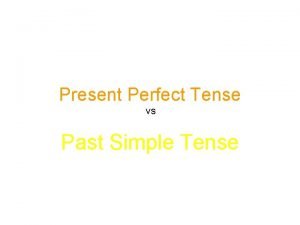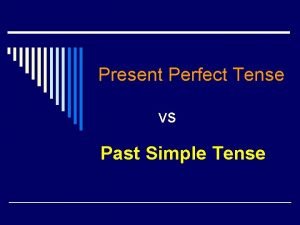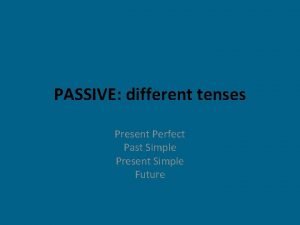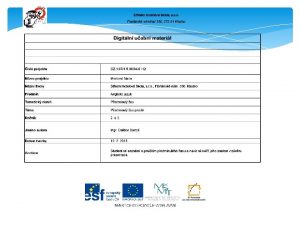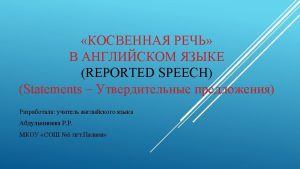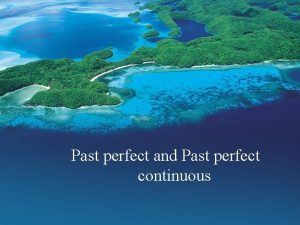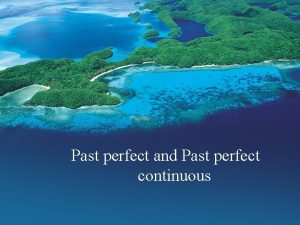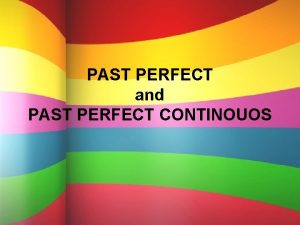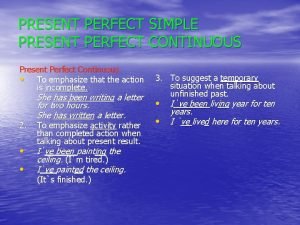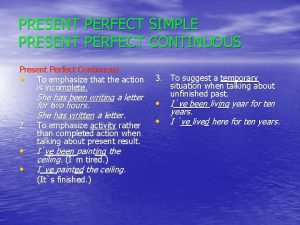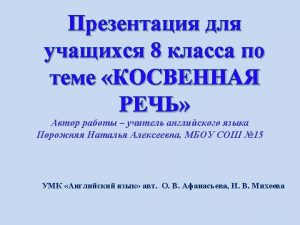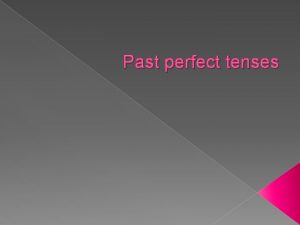1 Simple Past Present Perfect and Present Perfect















- Slides: 15

1 Simple Past, Present Perfect, and Present Perfect Progressive Adventure Travel Focus on Grammar 4 Part I, Unit 3 By Ruth Luman, Gabriele Steiner, and BJ Wells Copyright © 2006. Pearson Education, Inc. All rights reserved.

Adventure Travel Ad Are you looking for a little adventure in your life? Travel with me to beautiful Colorado. I’m an experienced river rafting and rock climbing guide. I’ve been guiding adventure travelers in this area for 10 years. In fact, last year, I took 30 trips down the Colorado River. Oh, and don’t worry about safety. I’ve also taken a number of first aid and safety courses. No one has ever broken any bones on my trips!

Simple Past 1 Use the simple past to talk about things that happened and were completed in the past. I rafted down the Nile River a year ago. I kayaked in the Grand Canyon for two months. rafted past future kayaked Use ago to show when something He’s not started. kayaking now

Perfect Tenses 1 Use the present perfect and the present perfect progressive to talk about things that started in the past, but were not completed. I have guided travelers my entire career. I have been rock climbing for 10 years. past future have guided have been rock climbing These things continue up to the present and may continue into the future. now

Remember! Non-action (stative) verbs are not usually used in the progressive. I’ve been knowing how to rock climb since I was young. I’ve known how to rock climb since I was young.

Perfect Tenses 2 We often use the present perfect and the present perfect progressive with for and since. Use for to show long something has been true and since to show when something started. I have trained for six years to take this trip. since 2000. He has been guiding trips since for six years past future have trained has been guiding since 2000 now

Simple Past 2 Use the simple past with past time expressions. lastyear. We trekked through the Andes Mountains last ago. He backpacked in Peru two months ago. past future d kk e tr ed c ba a p k e ck now

Be Careful! Don’t use specific time expressions with the present perfect except after since. last year. She has taken skydiving lessons last She took skydiving lessons last year. since 2004. She has taken skydiving lessons since

Practice 1 Fill in the blanks with the simple past, present perfect, or present perfect progressive forms of the verbs in parentheses. Dear Mom and Dad, I (sit) have sat/have been sitting here for hours looking at the beautiful birds in the rain forest. This vacation to Brazil (be) has been wonderful! I (see) so many amazing have seen animals since I arrived here. Last week, I (hike) through the forest to see the tree hiked monkeys. Our guide on that trip (tell) us told some very interesting information. I (learned) have learned/ have been learning so much on this trip! Love, Daniela

Present Perfect 1 Use the present perfect without time expressions to talk about things that happened at some indefinite time in the past. They have canoed down the Amazon River. time ? ? past future We don’t know when they canoed down the river, or the time is not important. now

Present Perfect 2 The present perfect without for or since shows that an activity is finished. We often say how many or how many times with this use of the present perfect. three times. He has visited Machu Picchu three past future now

Present Perfect Progressive The present perfect progressive shows that an activity is unfinished. We often say how long with the present perfect progressive. forfivehours. They have been climbing for past for five hours future have been climbing The activity is not finished. They’re still climbing. now

Present Perfect & Simple Past Use the present perfect or the simple past with unfinished time periods such as today, this week, this month, and this year. Notice the difference in meaning. She’s traveled to Alaska twice this month. She traveled to Alaska twice this month. The month isn’t over. She might travel again. The month isn’t over, but she probably won’t travel again this month.

Practice 2 Look at the groups of sentences. Discuss the differences in meaning with a partner. Example: a. I have visited Kenya three times this year. b. I visited Kenya three times this year. 1. a. I have taken many first-aid courses. 2. b. I have been taking many first-aid courses. 6. b. We have lived in Nepal for two years. 7. c. We have been living in Nepal for two years. The year isn’t over. The. She use rafted down the Nile River last week. over, but the 3. 2. a. of the present use of the perfect means 4. b. She has rafted down the Nile River. simple past that she might means that she return again to lived in Nepal for two years. probably won’t 5. 3. a. We Kenya. return to Kenya.

References Copyright © 2006 Pearson Education and its licensors. All rights reserved.
 Future continuous ejemplos
Future continuous ejemplos Past porfect
Past porfect Past tense past continuous past perfect
Past tense past continuous past perfect Past simple v present perfect
Past simple v present perfect Run present perfect
Run present perfect Went vs gone
Went vs gone Past simple vs present continuous
Past simple vs present continuous Present perfect passive
Present perfect passive Past simple future
Past simple future Present simple present continuous past simple future simple
Present simple present continuous past simple future simple Simple past simple present simple future
Simple past simple present simple future Future simple in the past
Future simple in the past Past perfect past continuous past simple
Past perfect past continuous past simple Past perfect simple
Past perfect simple 12 past tense
12 past tense Affirmative past progressive
Affirmative past progressive



